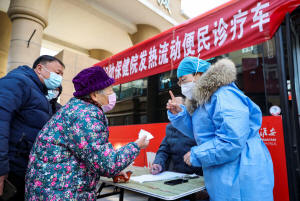Beijing, Shanghai residents back to work as China limps towards living
with COVID
 Send a link to a friend
Send a link to a friend
 [December 26, 2022]
By Martin Quin Pollard and Xihao Jiang [December 26, 2022]
By Martin Quin Pollard and Xihao Jiang
BEIJING/SHANGHAI (Reuters) -Mask-wearing Beijing and Shanghai commuters
crowded subway trains on Monday as China's two biggest cities edged
closer to living with COVID-19 even as frontline medical workers
scrambled to cope with millions of new infections.
After three years of harsh anti-coronavirus curbs, President Xi Jinping
scrapped China's zero-COVID policy of lockdowns and relentless testing
on Dec. 7 in the face of public protests and a widening outbreak.
"Our country's new coronavirus epidemic prevention and control is facing
new situations and new tasks," the official Xinhua news agency cited Xi
as saying on Monday in remarks on public health, marking one of his
first references to China's recent policy shift.
The virus is now spreading largely unchecked across the country of 1.4
billion people, with doubts mounting among health experts and residents
about Beijing's statistics, which show no new COVID deaths reported for
the six days through Sunday.
Doctors say hospitals are overwhelmed with five- to six-times more
patients than usual, mostly elderly.
All levels of government must further intensify their efforts to ensure
demand for medical treatment and supplies is being met, Premier Li
Keqiang was also quoted by Xinhua in its report as saying.

"I am prepared to live with the pandemic," said 25-year-old Shanghai
resident Lin Zixin. "Lockdowns are not a long-term solution."
This year, in an effort to prevent infections from spiralling out of
control across the country, the 25 million people in Shanghai - China's
commercial hub endured two months of bitter isolation under lockdown
that lasted until June 1.
Shanghai's lively streets on Monday contrasted sharply with the
atmosphere in April and May when hardly anyone went outside.
An annual Christmas market held at the Bund, a commercial district in
Shanghai, was popular with city residents over the weekend. Crowds
thronged the winter festive season at Shanghai Disneyland and Beijing's
Universal Studios on Sunday, queuing up for rides in Christmas-themed
outfits.
The number of trips to scenic spots in the southern city of Guangzhou
this weekend increased by 132% from last weekend, local newspaper The
21st Century Business Herald reported.
"Now basically everyone has returned to a normal routine," said a
29-year-old Beijing resident surnamed Han.
China is the last major country to move toward treating COVID as
endemic, lifting lockdowns and nearly all other restrictions on daily
life. Its containment measures had slowed the $17 trillion economy to
its lowest growth rate in nearly half a century, disrupting global
supply chains and trade.
The world's second-largest economy is expected to suffer further in the
short term, as the COVID wave spreads toward manufacturing areas and
workforces fall ill, before bouncing back next year, analysts say.

[to top of second column]
|

A medical worker provides instructions
to a resident at a mobile fever clinic converted from a bus amid the
coronavirus disease (COVID-19) outbreak, in Huaian, Jiangsu
province, China December 25, 2022. cnsphoto via REUTERS

Tesla suspended production at its Shanghai factory on Saturday,
advancing a plan to pause most work at the plant in the last week of
December. The company gave no reason.
'OVERWHELMED'
The world's most populous country has narrowed its definition for
classifying deaths as COVID-related, counting only those involving
COVID-caused pneumonia or respiratory failure, raising eyebrows
among world health experts.
The country's healthcare system has been under enormous strain, with
staff being asked to work while sick and retired medical workers in
rural communities being rehired to help, according to state media.
"The hospital is just overwhelmed from top to bottom," said doctor
Howard Bernstein at the privately owned Beijing United Family
Hospital.
The government of Zhejiang, a big industrial province near Shanghai
with a population of 65.4 million, said on Sunday it was battling
about a million new daily COVID-19 infections, a number expected to
double in the days ahead.
Health authorities in the southeastern Jiangxi province have said
infections would hit an apex in early January, adding that there
could be other peaks as people travel next month for Lunar New Year
celebrations, state media reported.
They warned that the wave of infections would last three months and
that about 80% of the province's 45 million residents could come
down with the virus.
The city of Qingdao, in the eastern province of Shandong, has
estimated that up to 530,000 residents were being infected each day.
Cities across China have been racing to add intensive-care units and
fever clinics, facilities designed to prevent the wider spread of
contagious disease in hospitals.
The Beijing municipal government has said the number of fever
clinics in the capital had risen from 94 to almost 1,300, state
media said. Shanghai has 2,600 such clinics and has transferred
doctors from less-strained medical departments to help out.

Worries linger about the ability of less-affluent cities in China to
cope with a surge in severe infections, especially as hundreds of
millions of rural migrant workers are expected to return to their
families for Lunar New Year.
"I am worried the flow of people will be huge ... (and) the epidemic
will break out again," said Lin, the Shanghai resident.
(Reporting by the Beijing and Shanghai bureaus; Writing by Marius
Zaharia; Editing by Gerry Doyle, Muralikumar Anantharaman and Mark
Heinrich)
[© 2022 Thomson Reuters. All rights
reserved.]
This material may not be published,
broadcast, rewritten or redistributed.
Thompson Reuters is solely responsible for this content. |